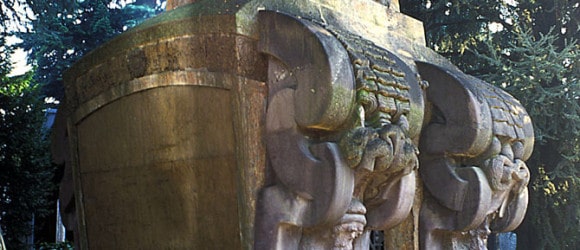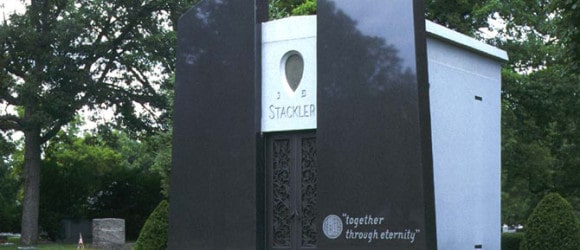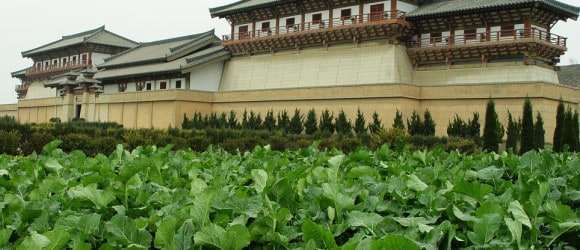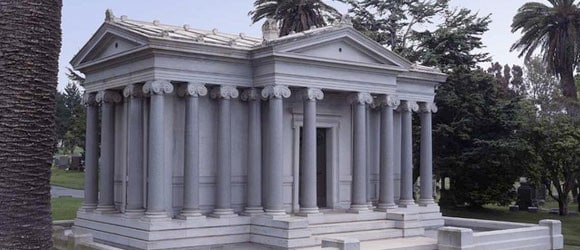What’s the Difference Between a Mausoleum and a Memorial?
- At September 04, 2013
- By mausoleum
- In General Information
 0
0
When considering how to commemorate the life of a loved one, a family may contemplate a mausoleum, a memorial, or another commemorative structure. The terms can get confusing, though, so what’s the difference between a mausoleum and a memorial?
Read More»Uniquely Funerary: Pierd’Houy Family Mausoleum
- At March 28, 2013
- By Doug Keister
- In Doug Keister's Blog
 0
0
When I was photographing and researching my first cemetery book, Going Out in Style: The Architecture of Eternity, I kept coming across mausoleums that didn’t neatly fit into any definite architectural style. These eclectic mausoleums might have some Gothic spires, Classical Revival columns, and Egyptian symbolism. I started to call this odd and sometimes wonderfully whimsical architecture “Uniquely Funerary”. You just aren’t likely to find this style of architecture anywhere else but a cemetery, or perhaps a fanciful theme park. Indeed, Uniquely Funerary mausoleums and funerary structures are a triumph of form over function. They may be thought of as a delightful marriage of sculpture and architecture.
Read More»The Mausoleum Enters the Twenty First Century
- At March 27, 2013
- By Doug Keister
- In Doug Keister's Blog
0
When I first began photographing mausoleums for my book Going Out in Style: The Architecture of Eternity in 1997, my primary focus was documenting historic mausoleums, mostly from the late nineteenth century. After all, my background was in photographing historic architecture (mostly Victorian and Arts and Crafts homes). Mausoleums were simply another type of historic residential architecture.
Almost every architectural or design style eventually makes it into the cemetery. When Napoleon invaded Egypt with both soldiers and artists, it triggered a phenomenon that became known as Egyptian Revival architecture thanks mostly to a French book of drawings by Napoleon’s artists, Description de l’Égypte, published in 1809. Egyptian Revival was, of course, the perfect architectural style for cemeteries and mausoleums since almost all Egyptian architecture had something to do with death and the afterlife.
The same can be said for Gothic Revival churches, Greek temples, and Art Deco theaters. All of those styles eventually made it into the cemetery in the form of mausoleums and other monuments.
Read More»The Human Cost of Early Mausolea
- At August 13, 2015
- By mausoleum
- In Mausoleum Design
0
A story came to light earlier this week of a massive find of more than 10,000 skeletons in what is being called the “criminal tombs”, dating back to about 202 BC, during the Chinese Han Dynasty. The name given this macabre find refers to the fact that many of the skeletal remains are bound by shackles and fetters.
As explained at this week’s Symposium for Research on Hanyang Mausoleum and Han Culture, the many remains were of prisoners who had been forced to build the Hanyang Mausoleum, and the tomb where Hanjingdi Liu Qi (188 – 141 DC), the fourth emperor of the Western Han Dynasty, and his wife are buried. There had been reports of an archaeological find of many prisoners as far back as 1972, but that excavation was more than a mile from this most recent discovery.
Read More»The Cemetery Mausoleum
A cemetery mausoleum offers an appealing opportunity to inter beloved family members above ground. Beautiful cemetery mausoleums draw admiration and appreciation from family members and strangers alike, and provide a permanent monument to the love and devotion that family members feel toward the deceased.
Read More»



